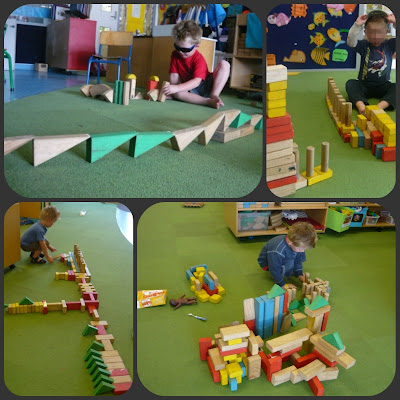This week I have observed R taking an interest in blocks. What started as a small amount of blocks with simple arrangements has now developed into intricate designs, sometimes built in a confined space upwards and sometimes extending in a long line across the room. The Ministry of Education (1995) describes technology as “a creative, purposeful activity aimed at meeting needs and opportunities through the development of products, systems, or environments. Knowledge, skills, and resources are combined to help solve practical problems” (p.6).
Block play is an excellent way in which technological processes are demonstrated and the block itself becomes a technological tool because it is an open ended resource that offers endless possibilities in design, problem solving and logical thinking (Rogers & Russo, 2003). R repeatedly played with blocks over extended periods of time and days which enabled him to gain knowledge about the properties of blocks (what they can and can’t do). As he worked with the blocks, R was also developing skill in balance, manipulation and design and so as the days passed, he was able to combine his newfound knowledge and skills to develop more intricate and elaborate designs.
Block play is an excellent way in which technological processes are demonstrated and the block itself becomes a technological tool because it is an open ended resource that offers endless possibilities in design, problem solving and logical thinking (Rogers & Russo, 2003). R repeatedly played with blocks over extended periods of time and days which enabled him to gain knowledge about the properties of blocks (what they can and can’t do). As he worked with the blocks, R was also developing skill in balance, manipulation and design and so as the days passed, he was able to combine his newfound knowledge and skills to develop more intricate and elaborate designs.
When R plays alone with the blocks, he is deep in thought and concentrates hard on what he is doing and seldom likes to be disturbed. This does not mean he doesn’t like to play with anyone else though! When he chooses to work with his peers, he is much more co-operative and works together with his friends to make wonderful creations.
As R and his friends work together, the technological processes occurring encourages “risk taking, lateral and divergent thinking, the development of multiple solutions to problems, trial and error, teamwork, and the management of resources effectively and efficiently” (Ministry of Education, 1995, p.8)



Wow Cathy this is such an amazing entry!
ReplyDeleteYou have gone into so much detail and made very good references. Your skill in academic writing is incredible. I loved this story about R and the blocks. I especially loved how you recognised how R is thinking when he plays with the blocks alone. I think that it is great how you acknowledged that he doesn’t like other children touching his work and often tells them to leave it. The fact that you didn’t step in and make him share (like most teacher respond) shows that you are a very professional teacher. I think that often teachers put a lot of emphasis on sharing toys and equipment and children are not given time or space to enjoy equipment by themselves. I love how you recognise and mention that when R does play with his peers that it is fair and co-operative. You obviously know this child well and haven’t jumped to conclusions.
Well done Cathy!
Hi Cathy
ReplyDeleteI enjoyed reading your blog about the blocks and the great photos that showed R’s block designs’ and creations. At my centre we have a 3 ½ year old girl who has created and constructed some amazing things out of blocks I wonder if she might grow up to be an engineer or architect. I was impressed at how R was able to work on his own when others wanted to join in. I think it is important that children have time to think and create independently. I sometimes think we are too quick to try and encourage children to play together and share toys. You mention later that R happily plays with others at different times so he already has social interaction skills. R is obviously very passionate about his creations and has shown that he is able to focus on an interest for a sustained amount of time.
You have some excellent theory that relates to the technological aspects related to block play. You increased my knowledge when you pointed out that a block is actually a technological tool in itself. From my own blog on blocks I was able to see how blocks foster technological knowledge. I was wondering how long R was able to leave his block constructions out on the floor and if you had thought about how to extend on this interest.
Padma